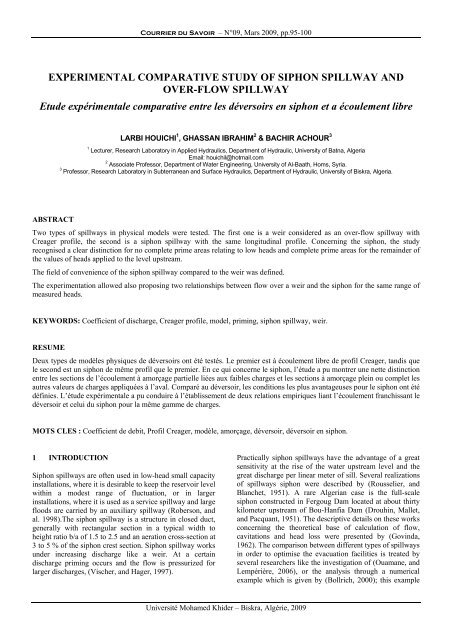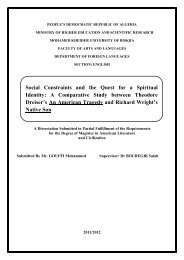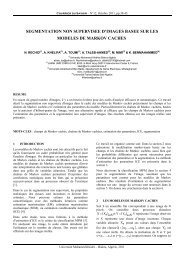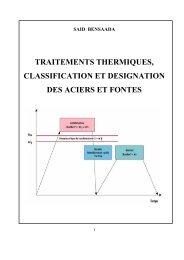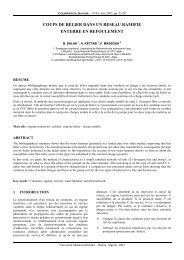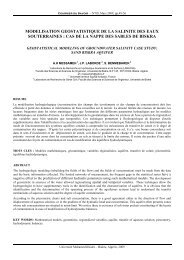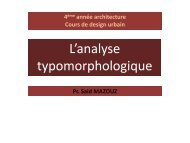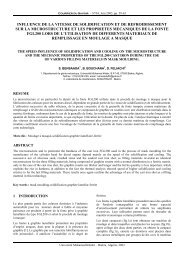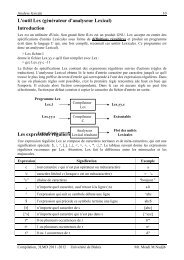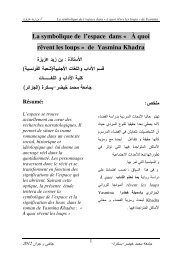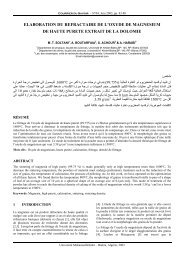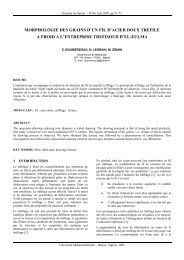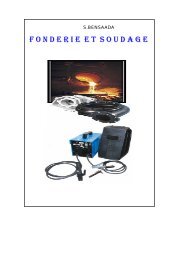Courrier du Savoir - Université Mohamed Khider de Biskra
Courrier du Savoir - Université Mohamed Khider de Biskra
Courrier du Savoir - Université Mohamed Khider de Biskra
You also want an ePaper? Increase the reach of your titles
YUMPU automatically turns print PDFs into web optimized ePapers that Google loves.
<strong>Courrier</strong> <strong>du</strong> <strong>Savoir</strong> – N°09, Mars 2009, pp.95-100<br />
EXPERIMENTAL COMPARATIVE STUDY OF SIPHON SPILLWAY AND<br />
OVER-FLOW SPILLWAY<br />
Etu<strong>de</strong> expérimentale comparative entre les déversoirs en siphon et a écoulement libre<br />
LARBI HOUICHI 1 , GHASSAN IBRAHIM 2 & BACHIR ACHOUR 3<br />
1 Lecturer, Research Laboratory in Applied Hydraulics, Department of Hydraulic, University of Batna, Algeria<br />
Email: houichil@hotmail.com<br />
2 Associate Professor, Department of Water Engineering, University of Al-Baath, Homs, Syria.<br />
3 Professor, Research Laboratory in Subterranean and Surface Hydraulics, Department of Hydraulic, University of <strong>Biskra</strong>, Algeria.<br />
ABSTRACT<br />
Two types of spillways in physical mo<strong>de</strong>ls were tested. The first one is a weir consi<strong>de</strong>red as an over-flow spillway with<br />
Creager profile, the second is a siphon spillway with the same longitudinal profile. Concerning the siphon, the study<br />
recognised a clear distinction for no complete prime areas relating to low heads and complete prime areas for the remain<strong>de</strong>r of<br />
the values of heads applied to the level upstream.<br />
The field of convenience of the siphon spillway compared to the weir was <strong>de</strong>fined.<br />
The experimentation allowed also proposing two relationships between flow over a weir and the siphon for the same range of<br />
measured heads.<br />
KEYWORDS: Coefficient of discharge, Creager profile, mo<strong>de</strong>l, priming, siphon spillway, weir.<br />
RESUME<br />
Deux types <strong>de</strong> modèles physiques <strong>de</strong> déversoirs ont été testés. Le premier est à écoulement libre <strong>de</strong> profil Creager, tandis que<br />
le second est un siphon <strong>de</strong> même profil que le premier. En ce qui concerne le siphon, l’étu<strong>de</strong> a pu montrer une nette distinction<br />
entre les sections <strong>de</strong> l’écoulement à amorçage partielle liées aux faibles charges et les sections à amorçage plein ou complet les<br />
autres valeurs <strong>de</strong> charges appliquées à l’aval. Comparé au déversoir, les conditions les plus avantageuses pour le siphon ont été<br />
définies. L’étu<strong>de</strong> expérimentale a pu con<strong>du</strong>ire à l’établissement <strong>de</strong> <strong>de</strong>ux relations empiriques liant l’écoulement franchissant le<br />
déversoir et celui <strong>du</strong> siphon pour la même gamme <strong>de</strong> charges.<br />
MOTS CLES : Coefficient <strong>de</strong> <strong>de</strong>bit, Profil Creager, modèle, amorçage, déversoir, déversoir en siphon.<br />
1 INTRODUCTION<br />
Siphon spillways are often used in low-head small capacity<br />
installations, where it is <strong>de</strong>sirable to keep the reservoir level<br />
within a mo<strong>de</strong>st range of fluctuation, or in larger<br />
installations, where it is used as a service spillway and large<br />
floods are carried by an auxiliary spillway (Roberson, and<br />
al. 1998).The siphon spillway is a structure in closed <strong>du</strong>ct,<br />
generally with rectangular section in a typical width to<br />
height ratio b/a of 1.5 to 2.5 and an aeration cross-section at<br />
3 to 5 % of the siphon crest section. Siphon spillway works<br />
un<strong>de</strong>r increasing discharge like a weir. At a certain<br />
discharge priming occurs and the flow is pressurized for<br />
larger discharges, (Vischer, and Hager, 1997).<br />
<strong>Université</strong> <strong>Mohamed</strong> <strong>Khi<strong>de</strong>r</strong> – <strong>Biskra</strong>, Algérie, 2009<br />
Practically siphon spillways have the advantage of a great<br />
sensitivity at the rise of the water upstream level and the<br />
great discharge per linear meter of sill. Several realizations<br />
of spillways siphon were <strong>de</strong>scribed by (Rousselier, and<br />
Blanchet, 1951). A rare Algerian case is the full-scale<br />
siphon constructed in Fergoug Dam located at about thirty<br />
kilometer upstream of Bou-Hanfia Dam (Drouhin, Mallet,<br />
and Pacquant, 1951). The <strong>de</strong>scriptive <strong>de</strong>tails on these works<br />
concerning the theoretical base of calculation of flow,<br />
cavitations and head loss were presented by (Govinda,<br />
1962). The comparison between different types of spillways<br />
in or<strong>de</strong>r to optimise the evacuation facilities is treated by<br />
several researchers like the investigation of (Ouamane, and<br />
Lempérière, 2006), or the analysis through a numerical<br />
example which is given by (Bollrich, 2000); this example
treats the comparison of the siphon with its similar weir.<br />
Comparison of the automatic flap gate spillways and siphon<br />
spillways is given by (Bessonneau, and Theret, 1979). In<br />
the same context of optimisation, a study concerning the<br />
rapid evacuation over steeply sloping overflow is presented<br />
by (Houichi, and Achour, 2007).<br />
The present contribution consists in making an<br />
experimental hydraulic study of the siphon Creager profile<br />
spillway, in or<strong>de</strong>r to <strong>de</strong>termine its capacity of discharge<br />
compared to weir Creager (1929) profile also, this profile is<br />
frequently used in evacuation facilities in almost all<br />
Algerian’s dams; In overflow spillways form such as<br />
Koudiat-Medouar Dam, Ain Zada Dam, Zit Emba Dam…<br />
or in sill of spillways such as Ghrib Dam, Sarno Dam,<br />
Fodda Dam, Foum-el-Gherza Dam… This comparison is<br />
appeared un<strong>de</strong>r the effect of the same heads applied at the<br />
level upstream. The siphon mo<strong>de</strong>l is <strong>de</strong>fined by a ratio b/a<br />
equal to 4 which corresponds to the maximum coefficient<br />
of discharge with value equal to 0.79 (Houichi, and al.,<br />
2006).This mo<strong>de</strong>l is selected from four mo<strong>de</strong>ls examined in<br />
the range ratio (1≤b/a≤4) (Houichi, 2007). The weir with<br />
free surface and Creager profile is <strong>de</strong>signed for head Hd =<br />
10cm. This head pro<strong>du</strong>ces generally a lower nappe of flow<br />
that agrees closely with spillway profile (Chow, 1981).The<br />
study seeks the limits of possibility of replacement of the<br />
weir largely used, by their similar siphon spillway which<br />
are not much used. The experimental values are consigned<br />
in tables 1 and 2 in the appendix.<br />
2 THEORETICAL RECALL OF THE RELATIONS<br />
OF DISCHARGE CALCULATIONWeir type<br />
Creager<br />
The discharge over the weir with Creager profile according<br />
to the schema of the figure 1 is given by a well-known<br />
theoretical relation:<br />
Where:<br />
Q mb gH<br />
3 2<br />
= 2<br />
(1)<br />
weir<br />
Qweir: discharge of weir (m 3 /s)<br />
m: coefficient of discharge of weir<br />
b: width of crest (m)<br />
g: gravity acceleration (m/s 2 )<br />
H: head above the crest (m.)<br />
E: the vertical distance from the crest of sill to the floor at<br />
the downstream apron (m).<br />
96<br />
Figure 1: Weir with Creager profile<br />
2.2 Siphon spillway<br />
L. Houichi & al.<br />
The discharge over the siphon consi<strong>de</strong>red as a pressurized<br />
con<strong>du</strong>ct is given by the following relation according to the<br />
schema of the figure 2:<br />
Q = μ A 2 gH<br />
(2)<br />
Where:<br />
s act<br />
Qs: Discharge of siphon spillway (m 3 /s)<br />
µ: Coefficient of discharge for siphon<br />
A: cross-section at crest of siphon equal to b×a (m 2 )<br />
a: vertical dimension of cross-section at crest and exit<br />
section of siphon (m)<br />
b: horizontal dimension of cross-section of siphon (m)<br />
g: gravity acceleration (m/s 2 )<br />
E: the vertical distance from the crest of sill to the floor at<br />
the downstream apron (m).<br />
Hact: actual head according conditions of flow at exit of<br />
siphon according to the schema on figure 2.<br />
H = E + H − a'<br />
(3)<br />
act<br />
With:<br />
a ' : flow <strong>de</strong>pth on downstream.<br />
Figure 2: Siphon with Creager profile; Siphon-exit drowned
3 EXPERIMENTAL STUDY<br />
3.1 Installation<br />
The experimental station (photography 1) is a hydraulic<br />
system formed by a physical spillway mo<strong>de</strong>l at overflow<br />
crest divi<strong>de</strong>d into two parts of width b = 17.2 cm each. The<br />
first one is used as a weir with free surface Creager profile<br />
for <strong>de</strong>sign head Hd = 10cm and the broad range of head<br />
above the crest from 2 to 18 cm (photography 2 on the left);<br />
the second one is used as a siphon spillway (photography 2<br />
on the right) with rectangular opening (Figures 3) for a<br />
longitudinal section also with Creager profile, owning a<br />
vertical dimension a = 4.3 cm of the cross section and<br />
horizontal dimension b = 17.2 cm , the ratio b/a = 4, and a<br />
total surface A = 73.96 cm 2 . The vertical distance from the<br />
crest of sill to the floor at the downstream apron is E = 70.3<br />
cm. The siphon is equipped with area orifices equal to 5 %<br />
of the surface of the section of the siphon measured at the<br />
crest (photography 3, figure 4); these orifices ensure the<br />
automatic stop of the siphon operation when water reaches<br />
the crest of sill at the level upstream. The siphon functions<br />
at the beginning as weir then it prime when the openings<br />
are drowned, being transformed thus as pressurized <strong>du</strong>cted<br />
with length equal to 1.10 m which leads to a stilling basin<br />
for 5 cm of <strong>de</strong>pth. The mo<strong>de</strong>l is constructed in clear<br />
Perspex; it is fed in closed loop, starting from an elevated<br />
tank supplied by pumping from a second un<strong>de</strong>rground tank.<br />
The flows are measured by an ultra sonic flow meter, type<br />
(1010WP Ultrasonic).<br />
Photography 1. Experimental station<br />
Photography 2. Left: Weir Creager profile;Right: Siphon Spillway<br />
Experimental comparative study of siphon spillway and over-flow spillway<br />
97<br />
a = 4.3cm<br />
Photography 3. Entrance and aeration orifices<br />
18.<br />
5 cm<br />
b = 17.<br />
2 cm<br />
Figure 3: Siphon with rectangular opening (b×a) = (17.2×4.3 cm);<br />
b/a = 4<br />
Figure 4: Entrance and crest of siphon; a = 4.3cm; R1 = 3.45 cm;<br />
R2 = 7.75 cm<br />
3.2 Discussions of Results<br />
3.2.1 Complete priming of siphon<br />
When the rectangular siphon <strong>du</strong>ct operates with full section<br />
without of air bubbles, the work is consi<strong>de</strong>red in complete<br />
priming; thus it is possible to conclu<strong>de</strong>:<br />
A clear distinction of the no complete priming areas, for<br />
low head values applied to the level upstream of the siphon,<br />
as well as a complete priming area beginning at the<br />
operation point characterized by a head H equal to (a = 4.3<br />
cm).<br />
The value of the priming flow Qspriming at head H is 20.20l/s<br />
when the siphon operates with total section A = 73.96cm 2 .<br />
The variation of Qs (H) is shown in figure 5.
24<br />
23<br />
22<br />
21<br />
20<br />
19<br />
18<br />
Qs (l/s)<br />
H (cm)<br />
4 6 8 10 12 14 16 18 20<br />
Figure 5: Variation of Qs (H) with total cross-section A = 73.96cm 2<br />
3.2.2 Cavitation control by the vortex theory<br />
As shown in figure 4 let R1 be the radius of the crest and R2<br />
be the radius of the crown of the siphon. If h0 is the<br />
negative head at the crest; according to Modi (2000, p671)<br />
the discharge Qs is given from the condition of free vortex<br />
flow as:<br />
R<br />
Q = bR gh<br />
(4)<br />
s<br />
2<br />
1 2 0 ln( )<br />
R1<br />
If cavitation is to be avoi<strong>de</strong>d, the maximum negative head<br />
(vacuum) at the crest may be 7.92 m; it is the difference<br />
between the atmospheric pressure at height above the sea<br />
level and the vapour pressure.<br />
Thus substituting h0 = 7.92 m in equation 4, we get<br />
R2<br />
Qs max = 12.<br />
47bR1<br />
ln( )<br />
(5)<br />
R1<br />
The numerical value is obtained for present case as:<br />
b=17.2cm; R1=3.45 cm; R2 =7.75 cm<br />
Qsmax = 0.0599 m 3 /s or Qsmax ≈ 60 l/s<br />
Whence, in range of discharge used (Qs≤ 22.5 l/s), no<br />
cavitation problems should arise in the siphon.<br />
3.2.3 Expression for the head loss in the entire siphon<br />
After the siphon spillway get primed and is running full,<br />
consi<strong>de</strong>r V1, V2 and V3 the velocities of flow at entrance,<br />
crest and exit end respectively. Let hL be the head loss in the<br />
entire siphon between entrance and the exit end. The <strong>de</strong>tails<br />
of the entrance conditions are given in (figure 4 and<br />
photography 3).<br />
Since the cross-section areas at the crest and the exit end of<br />
the siphon <strong>du</strong>ct are equal we can write<br />
Q =<br />
s = AV2<br />
AV3<br />
(6)<br />
98<br />
and<br />
L. Houichi & al.<br />
Qs = A 2g( H act − hL<br />
)<br />
(7)<br />
Thus equating both the values of Qs from equation 2 and 7,<br />
we get<br />
2<br />
h L = ( 1 − µ ) H act<br />
(8)<br />
The values of head loss in the entire siphon can be<br />
calculated according equation 8.<br />
3.2.4 Capacity of evacuation of the siphon compared to weir<br />
For limiting the fields where the capacity of evacuation of<br />
the siphon with Creager’s profile, having Qs flows is better<br />
when it’s compared to its similar weir which has Qweir<br />
flows un<strong>de</strong>r the same operating conditions and the same<br />
head applied at the upstream level, we have represented ,on<br />
figure 6, the variation of Qs/Q<strong>de</strong>v versus H/a ratio for siphon<br />
with total section and weir characterized by a width of the<br />
sill b = 17.2 cm. This representation makes possible to<br />
prove that the capacity of evacuation of siphon is better<br />
than weir if the value of the ratio H/a is lower than 3.50.<br />
9<br />
8<br />
7<br />
6<br />
5<br />
4<br />
3<br />
Qs/Qweir<br />
2<br />
1<br />
0<br />
H/a<br />
0.5 1 1.5 2 2.5 3 3.5 4 4.5<br />
Figure 6: Variation of Qs/Qweir vs. H/a with total cross-section A =<br />
73.96 cm 2<br />
30<br />
25<br />
20<br />
15<br />
10<br />
5<br />
0<br />
Q (l/s)<br />
H (cm)<br />
0 2 4 6 8 10 12 14 16 18 20<br />
Weir Siphon mo<strong>de</strong>l<br />
Figure 7: Variation of Qs (H) vs. Qweir (H).
Referring to figure 7 and consi<strong>de</strong>ring the siphon mo<strong>de</strong>l<br />
compared to weir for the low heads which do not ensure<br />
priming, we can announce that the average coefficient of<br />
discharge has a value µ = 0.729 (table.2) that is lower than<br />
0.791 which corresponds to siphon at its maximum<br />
capacity. he average coefficient of discharge of the weir for<br />
the same heads is certainly lower than 0.501 which<br />
corresponds to the <strong>de</strong>sign point. This value is m = 0.356<br />
(table.1).<br />
In these conditions the evacuation over the siphon is much<br />
better than the one ensured by the weir what confirms that<br />
siphons spillways have a great sensitivity at the rise of the<br />
water upstream level and the great discharge per linear<br />
meter of sill. The works are then related by the following<br />
relationship:<br />
qs w<br />
= 2.7 q + 0.<br />
1<br />
(9)<br />
Knowing that:qs: specific flow of the siphon in (l/s/m 2 ),<br />
calculated by:<br />
q Qs<br />
b<br />
s = (10)<br />
qw: specific flow of the weir in (l/s/m 2 ), calculated by:<br />
q Qw<br />
b<br />
w = (11)<br />
Referring to figure 7 also and consi<strong>de</strong>ring the siphon mo<strong>de</strong>l<br />
at priming estate (H≥4.3cm) compared to weir for the wi<strong>de</strong><br />
range 1≤ H/a ≤ 4 .Two types spillways are related by the<br />
following relationship:<br />
Q<br />
Q<br />
s<br />
w<br />
⎛ H<br />
= 7 ⎜<br />
⎝ a<br />
⎞<br />
⎟<br />
⎠<br />
−1.<br />
57<br />
Experimental comparative study of siphon spillway and over-flow spillway<br />
(12)<br />
Equation12 was obtained with correlation coefficient R<br />
greater than 0.9999.<br />
The limit inferior for the range of validity of equation 12 is<br />
given by the state of priming contrariwise the limit superior<br />
is dictated by the experimental laboratory conditions which<br />
cannot give beyond this value.<br />
4 CONCLUSIONS<br />
The capacity of discharge of weir and siphon spillway<br />
profiled in Creager type was theoretically remin<strong>de</strong>d from<br />
and experimentally examined. The comparative study of<br />
mo<strong>de</strong>ls siphon spillway and weir ma<strong>de</strong> possible to <strong>de</strong>fine<br />
the fields according to value of the ratio H/a where the<br />
siphon is consi<strong>de</strong>red to be better in evacuation than the weir<br />
un<strong>de</strong>r the same conditions of flow and vice versa.<br />
Finally, the study presents linear and non linear<br />
relationships between the flow over the weir consi<strong>de</strong>red as<br />
an over-flow spillway and the siphon spillway.<br />
NOTATION<br />
A Total cross-section of evacuation (m 2 )<br />
99<br />
a vertical dimension of cross-section at crest and exit<br />
section of siphon (m)<br />
a ' Flow <strong>de</strong>pth on downstream (m)<br />
b width crest of weir and horizontal dimension of<br />
siphon cross-section (m)<br />
E the vertical distance from the crest of sill to the<br />
floor at the downstream apron (m)<br />
g gravitational acceleration (ms -2 )<br />
H head above the crest (m)<br />
<strong>de</strong>sign head (m)<br />
Hd<br />
Hact actual head according conditions of flow at exit of<br />
siphon (m.)<br />
m Coefficient of discharge for weir (-)<br />
Qweir Discharge of weir (m3 s -1 )<br />
qweir<br />
Qs<br />
Specific discharge for weir (m 3 s -1 m -2 )<br />
Discharge of Siphon spillway (m 3 s -1 )<br />
qs Specific discharge for siphon (m 3 s -1 m -2 )<br />
µ Coefficient of discharge for siphon (-)<br />
REFERENCES<br />
[1] Bessonneau, M., Theret, B. (1979). ″Automatic flap<br />
gate spillways and siphon spillways- Comparaison and<br />
advantages of both systems″, ICOLD, 13 th congress,<br />
New Delhi, India.<br />
[2] Bollrich, G. (2000). ″Technische Hydromechanik″,<br />
Band 1, 4. Auflage, Verlag fur Bauwesen Berlin.<br />
Germany.<br />
[3] Chow,V.T. (1981). ″Open-Channel Hydraulics ″,<br />
International Stu<strong>de</strong>nt Edition, McGraw-Hill, 17 th<br />
Printing, Tokyo,China.<br />
[4] Creager, W.P. (1929). ″Engineering of Masonry<br />
[5]<br />
Dams″. John Wiley & Sons, New York, USA.<br />
Drouhin, G., Mallet, Ch. and Pacquant. J. (1951).<br />
″Contribution to the study of the rate of flow and the<br />
<strong>de</strong>termination of flood discharge″. ICOLD, 4th<br />
congress, New Delhi, India.<br />
[6] Govinda, Rao,N.S. (1962). ″Hydraulics″, Asia<br />
publishing house, India.<br />
[7] Houichi, L., Ghassan, I., Achour, B. (2006).″<br />
Experiments for the discharge capacity of the siphon<br />
spillway having the Creager-Ofitserov profile″.<br />
International journal of fluid mechanics research,<br />
Volume33, Number5, Begell house, Inc.,USA.<br />
[8] Houichi, L., Achour, B. (2007).″ Flow <strong>de</strong>pth<br />
computation at the toe of an overflow dam in steeply<br />
sloping case″. Dam Engineering, Volume XVII, Issue
4, Wilmington Media, UK.<br />
[9] Houichi, L. (2007). ″ Ouvrages d’évacuation ″.<br />
Doctorate Thesis, University of Batna, Algeria.<br />
[10] Ouamane, A. Lempérière, F. (2006). ″Nouvelle<br />
conception <strong>de</strong> déversoir pour l’accroissement <strong>de</strong> la<br />
capacité <strong>de</strong>s retenues <strong>de</strong>s barrages″. Colloque<br />
International sur la Protection et la préservation <strong>de</strong>s<br />
ressources en eau. Blida. Algérie<br />
[11] Roberson, J.A.,Cassidy, J.J., Chaudhry,M.H.(1998).<br />
″Hydraulic engineering″, Second edition. John Wiley<br />
& Sons, New York, USA.<br />
[12] Rousselier,M., Blanchet, P. (1951). ″Some realizations<br />
of siphons″, ICOLD, 4th congress, New Delhi, India.<br />
[13] Vischer, D.L., Hager,W.H. (1997). ″Dam hydraulics″,<br />
John Wiley and Sons Ltd, England.<br />
APPENDIX 1<br />
Table 1. Experimental measurements: Weir with width sill<br />
equal to 17.2 cm<br />
N° H<br />
(cm)<br />
Qweir (l/s)<br />
m<br />
(-)<br />
1 1,5 0,46 0,33<br />
2 1,65 0,54 0,34<br />
3 1,7 0,57 0,34<br />
4 2 0,75 0,35<br />
5 2,2 0,82 0,35<br />
6 2,5 1,10 0,366<br />
7 3 1,51 0,380<br />
8 3,5 1,96 0,393<br />
9 4 2,46 0,404<br />
10 4,3 2,78 0,410<br />
11 5 3,60 0,423<br />
12 5,5 4,24 0,431<br />
13 6 4,96 0,443<br />
14 6,5 5,62 0,445<br />
15 7 6,42 0,455<br />
16 7,5 7,13 0,456<br />
17 8 7,91 0,459<br />
18 9 9,59 0,466<br />
19 10 12,04 0,501<br />
20 11 13,68 0,492<br />
21 12 15,46 0,488<br />
22 13 17,48 0,489<br />
23 14 19,50 0,489<br />
24 15 21,63 0,489<br />
25 16 23,87 0,490<br />
26 17 26,22 0,491<br />
27 18 28,67 0,493<br />
APPENDIX 2<br />
100<br />
N° Qs<br />
(l/s)<br />
L. Houichi & al.<br />
Table 2. Experimental measurements: Siphon mo<strong>de</strong>l<br />
H<br />
(cm)<br />
E<br />
(cm)<br />
a’<br />
(cm)<br />
H act<br />
)cm(<br />
A<br />
(cm 2 )<br />
1 16,90 1,1 13 58,4 0,675<br />
2 17 ,00 1,2 13 58,5 0,678<br />
3 17,50 1,4 13 58,7 0,697<br />
4 18,50 1,5 13 58,8 0,736<br />
5 18,85 1,65 13 58,95 0,749<br />
6 18,90 1,7 13 59 0,751<br />
7 19,44 2 13 59,3 0,771<br />
8 19,50 2,1 13 59,4 0,772<br />
9 19,70 2,2 13 59,5 0,780<br />
10 20,20 4,3<br />
70,3<br />
13 61,6<br />
73,96<br />
0,786<br />
11 20,40 5,4 13 62,7 0,786<br />
12 20,50 5,7 13 63 0,788<br />
13 20,60 5,9 13 63,2 0,791<br />
14 20,90 7,6 13 64,9 0,792<br />
15 21,00 8,4 13 65,7 0,791<br />
16 21,60 12 13 69,3 0,792<br />
17 21,90 14,1 13 71,4 0,791<br />
18 22,00 14,5 13 71,8 0,793<br />
19 22,30 16,5 13 73,8 0,792<br />
20 22,50 17,4 13 74,7 0,795<br />
µ<br />
(-) Observation<br />
No complete<br />
priming<br />
Complete<br />
priming


